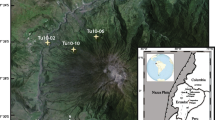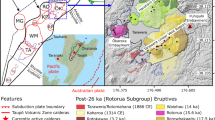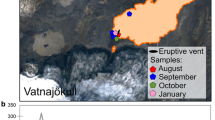Abstract
The sequence of eruptions in the Bandelier magmatic system provides an opportunity to study volatile evolution through different stages of a large silicic magma chamber. The Lower Bandelier Tuff (LBT) and Upper Bandelier Tuff (UBT) eruptions offer a snapshot of a pre-eruptive magma chamber primed for eruption, while the sequence of Valle Toledo Member (VTM) eruptions open a window into the temporal evolution of the chamber’s upper regions between the two super-eruptions. We measured H2O and CO2 concentrations in melt inclusions from the entire sequence of eruptions and identified three peaks in CO2 concentrations: (1) in the middle of the LBT plinian airfall (increase in mean CO2 concentrations from 27 ± 5 ppm at the base of the plinian to 173 ± 5 ppm in the mid-plinian); (2) in VTM group III (mean of 197 ± 5 ppm); and (3) in the middle of the UBT plinian airfall (mean of 54 ± 5 ppm at the base of the plinian to 101 ± 5 ppm in the mid-plinian). We propose that these increased CO2 concentrations are due to injections of fresh magma into the system, whereby CO2-rich vapours exsolved from the injected magma percolated through the magma chamber to increase CO2 levels. Although the sharp increase in the LBT plinian indicates a rapid succession of recharge events in a short period of time, the gradually increasing CO2 levels through the final VTM phase and the UBT plinian indicate that recharge events may have been spread over a longer period of time before the UBT eruption. Based on the theoretical and observed gradients in H2O and CO2 through the LBT and UBT sequence, we calculate a vapour phase equivalent to maximum 6.7 wt% of the magma body was exsolved from the LBT magma chamber; for the less degassed UBT, the exsolved vapour phase was maximum 4.2 wt% of the magma body. Our results indicate that the volatile composition of magmatic systems, with a particular focus on CO2, can record evidence of magmatic recharge into the system and be an important tool in deciphering recharge events.
Similar content being viewed by others
Data availability
Dataset available as supplementary material.
Code availability
Not applicable.
References
Audétat A, Lowenstern JB (2014) Melt inclusions. In: Turekian K, Holland H (eds) Treatise on geochemistry, 2nd edn. Elsevier, pp 143–173
Bachmann O, Bergantz GW (2004) On the origin of crystal-poor rhyolites: extracted from batholithic crystal mushes. J Petrol 45:1565–1582
Bachmann O, Bergantz GW (2006) Gas percolation in upper-crustal silicic crystal mushes as a mechanism for upward heat advection and rejuvenation of near-solidus magma bodies. J Volcanol Geoth Res 149:85–102
Bachmann O, Bergantz GW (2008) Rhyolites and their source mushes across tectonic settings. J Petrol 49:2277–2285
Balsley SD (1988) The petrology and geochemistry of the Tshirege Member of the Bandelier Tuff, Jemez Mountains volcanic field, New Mexico, U.S.A. MSc thesis, University of Texas at Arlington
Behrens H, Tamic N, Holtz F (2004) Determination of the molar absorptions coefficient for the infrared absorption band of CO2 in rhyolitic glasses. Am Miner 89:301–306
Blundy J, Cashman KV, Rust A, Witham F (2010) A case for CO2-rich arc magmas. Earth Planet Sci Lett 290:289–301
Boro JR, Wolff JA, Neill OK (2020) Anatomy of a recharge magma: Hornblende dacite pumice from the rhyolitic Tshirege Member of the Bandelier Tuff, Valles Caldera, New Mexico, USA. Contrib Miner Petrol 175:1–26
Broxton DE, Heiken GH, Chipera SJ, Byers FM Jr (1995) Stratigraphy, petrography, and mineralogy of Bandelier Tuff and Cerro Toledo deposits. Earth Sci Invest Environ Restoration 21:33–65
Brundstad KA (2013) Origin and evolution of large silicic caldera complex: Valles caldera and the associated Upper Bandelier Tuff. PhD thesis, Washington State University
Campbell ME, Hanson JB, Minarik WG, Stix J (2009) Thermal history of the Bandelier magmatic system: evidence for magmatic injection and recharge at 1.61 Ma as revealed by cathodoluminescence and titanium geothermometry. J Geol 117:469–485
Caress ME (1996). Zonation of alkali feldspar compositions in the Tshirege Member of the Bandelier Tuff in Pueblo Canyon, near Los Alamos, New Mexico. In: Goff F, Kues BS, Roger MA, McFadden LS & Gardner JN (eds) Jemez Mountains Region. New Mexico Geological Society 47th Annual Fall Field Conference Guidebook, pp 275–283
Caricchi L, Sheldrake TE, Blundy J (2018) Modulation of magmatic processes by CO2 flushing. Earth Planet Sci Lett 491:160–171
Collins SJ, Pyle DM, Maclennan J (2009) Melt inclusions track pre-eruption storage and dehydration of magmas at Etna. Geology 37:571–574
Cook GW, Wolff JA, Self S (2016) Estimating the eruptive volume of a large pyroclastic body: the Otowi member of the Bandelier Tuff, Valles caldera, New Mexico. Bull Volcanol 78:10. https://doi.org/10.1007/s00445-016-1000-0
Dallai L, Cioni R, Boschi C, D’Oriano C (2011) Carbonate-derived CO2 purging magma at depth: Influence on the eruptive activity of Somma-Vesuvius, Italy. Earth Planet Sci Lett 310:84–95
Deegan FM, Troll VR, Freda C, Misiti V, Chadwick JP, McLeod CL, Davidson JP (2010) Magma-carbonate interaction processes and associated CO2 release at Merapi volcano, Indonesia: Insights from experimental petrology. J Petrol 51:1027–1051
Devine JD, Gardner JE, Brack HP, Layne GD, Rutherford MJ (1995) Comparison of microanalytical methods for estimating H2O contents of silicic volcanic glasses. Am Miner 80:319–328
Duan Z, Møller N, Weare JH (1995) Equation of state for the NaCl-H2O-CO2 system: prediction of phase equilibria and volumetric properties. Geochim Cosmochim Acta 59:2869–2882
Dunbar NW, Hervig RL (1992) Volatile and trace element composition of melt inclusions from the Lower Bandelier Tuff: implications for magma chamber processes and eruptive style. J Geophys Res 97:151–170
Eichelberger JC, Koch FG (1979) Lithic fragments in the Bandelier Tuff, Jemez Mountains, New Mexico. J Volcanol Geoth Res 5:115–134
Evans BW, Hildreth W, Bachmann O, Scaillet B (2016) In defense of magnetite-ilmenite thermometry in the Bishop Tuff and its implication for gradients in silicic magma reservoirs. Am Miner 101:469–482
Gardner JN, Goff F, Kelley S, Jacobs E (2010) Rhyolites and associated deposits of the Valles-Toledo caldera complex. New Mex Geol 32:3–18
Gerlach TM, Westrich HR, Casadevall TJ, Finnegan DL (1994) Vapor saturation and accumulation in magmas of the 1989–1990 eruption of redoubt Volcano, Alaska. J Volcanol Geoth Res 62:317–337
Goff F (2010) The Valles caldera: new Mexico’s supervolcano. New Mexico Earth Matters 10:1–4
Goff F, Gardner JN (2004) Late Cenozoic geochronology of volcanism and mineralization in the Jemez Mountains and Valles caldera, north central New Mexico. In: Mack GH, Giles KA (eds) The geology of New Mexico: a geologic history. New Mexico Geological Society Special Publication, pp 295–311
Goff F, Gardner JN, Baldridge WS, Hulen JB, Nielson DL, Vaniman D, Heiken G, Dungan MA, Broxton D (1989) Excursion 17B: Volcanic and hydrothermal evolution of Valles caldera and Jemez volcanic field. N Mex Bur Mines Miner Resource Mem 46:381–434
Goff F, Warren RG, Goff CJ, Dunbar N (2014) Eruption of reverse-zoned upper Tshirege Member, Bandelier Tuff from centralized vents within Valles caldera, New Mexico. J Volcanol Geoth Res 276:82–104
Goff F, Gardner JN, Reneau SL, Kelley SA, Kempter KA, Lawrence JR (2011) Geologic map of the Valles caldera, Jemez Mountains, New Mexico. New Mexico Bureau of Geology and Mineral Resources, Geologic Map 79, scale 1:50,000
Griggs RL (1964) Geology and groundwater resources of the Los Alamos area New Mexico. Geological Survey Water-supply paper 1753. U.S. Government Printing Office, Washington, DC. https://doi.org/10.3133/wsp1753
Gualda GAR, Ghiorso MS (2013) The Bishop Tuff giant magma body: an alternative to the Standard Model. Contrib Miner Petrol 166:755–775
Heiken G, Goff F, Stix J, Tamanyu S, Shafiqullah M, Garcia S, Hagan R (1986) Intracaldera volcanic activity, Toledo Caldera and Embayment, Jemez Mountains, New Mexico. J Geophys Res 91:1799–1815
Hervig RL, Dunbar NW (1992) Cause of chemical zoning in the Bishop (California) and Bandelier (New Mexico) magma chambers. Earth Planet Sci Lett 111:97–108
Holloway JR, Burnham CW (1972) Melting relations of basalt with equilibrium water pressure less than total pressure. J Petrol 13:1–29
Jacobs EP, Kelley SA (2007) The time between the tuffs: deposits of the Cerro Toledo interval in Bandelier National Monument, New Mexico. In: Kues BS, Kelley SA, Lueth VW (eds) Geology of the Jemez Region II. New Mexico Geological Society 58th Annual Fall Field Conference Guidebook, pp 308–315
Kennedy B, Wilcock J, Stix J (2012) Caldera resurgence during magma replenishment and rejuvenation at Valles and Lake City calderas. Bull Volcanol 74:1833–1847
Kuentz DC (1986) The Otowi Member of the Bandelier Tuff: A study of the petrology, petrography, and geochemistry of an explosive silicic eruption, Jemez Mountains, New Mexico. MSc thesis, University of Texas at Arlington
Lowenstern JB (2001) Carbon dioxide in magmas and implications for hydrothermal systems. Miner Deposita 36:490–502
Lucic G, Berg A-S, Stix J (2016) Water-rich and volatile-undersaturated magmas at Hekla volcano, Iceland. Geochem Geophys Geosyst 17:3111–3130
Luhr JF (2001) Glass inclusions and melt volatile contents at Parícutin volcano, Mexico. Contrib Miner Petrol 142:261–283
Newman S, Lowenstern JB (2002) Volatile calc: a silicate melt–H2O–CO2 solution model written in visual basic for excel. Comput Geosci 28:597–604
Newman S, Stolper EM, Epstein S (1986) Measurement of water in rhyolitic glasses-calibration of an infrared spectroscopic technique. Am Miner 71:1527–1541
Newman S, Epstein S, Stolper E (1988) Water, carbon dioxide, and hydrogen isotopes in glasses from the ca. 1340 A.D. eruption of the Mono Craters, California: constraints on degassing phenomena and initial volatile content. J Volcanol Geoth Res 35:75–96
Nielson DL, Hulen JB (1984) Internal geology and evolution of the Redondo dome, Valles caldera, New Mexico. J Geophys Res 89:8695–8711
Phillips EH, Goff F, Kyle PR, McIntosh WC, Dunbar NW, Gardner JN (2007) The 40Ar/39Ar age constraints on the duration of resurgence at the Valles caldera, New Mexico. J Geophys Res. https://doi.org/10.1029/2006JB004511
Rowe MC, Wolff JA, Gardner JN, Ramos FC, Teasdale R, Heikoop CE (2007) Development of a continental volcanic field: petrogenesis of pre-caldera intermediate and silicic rocks and origin of the Bandelier magmas, Jemez Mountains (New Mexico, USA). J Petrol 48:2063–2091
Self S, Goff F, Gardner JN, Wright JV, Kite WM (1986) Explosive rhyolitic volcanism in the Jemez Mountains: vent locations, caldera development and relation to regional structure (USA). J Geophys Res 91:1779–1798
Severs MJ, Azbej T, Thomas JB, Mandeville CW, Bodnar RJ (2007) Experimental determination of H2O loss from melt inclusions during laboratory heating: evidence from Raman spectroscopy. Chem Geol 237:358–371
Slate JL, Sarna-Wojicki AM, Wan E, Dethier DP, Wahl DB, Lavine A (2007) A Chronostratigraphic Reference Set of Tephra Layers From the Jemez Mountains Volcanic Source, New Mexico. In: Kues BS, Kelley SA, Lueth VW (eds) Geology of the Jemez Region II. New Mexico Geological Society 58th Annual Fall Field Conference Guidebook, pp 239–247
Smith RL (1979) Ash-flow magmatism. Geol Soc Am Spec Pap 180:5–27
Smith RL, Bailey RA (1968) Resurgent cauldrons. In: Coats RR, Hay RL, Anderson CA (eds) Studies in volcanology, vol 116. Geological Society of America Memoirs, pp 613–662
Smith RL, Bailey RA, Ross CS (1970) Geologic map of the Jemez Mountains, New Mexico. U.S. Geologic Survey, map I-571, scale 1:125,000. https://doi.org/10.3133/i571
Sommer MA (1977) Volatiles H2O, CO2 and CO in silicate melt inclusions in quartz phenocrysts from the rhyolitic Bandelier air-fall and ash-flow tuff, New Mexico. J Geol 85:423–432
Spell TL, Harrison TM, Wolff JA (1990) 40Ar/39Ar dating of the Bandelier Tuff and San Diego Canyon ignimbrites, Jemez Mountains, New Mexico: temporal constraints on magmatic evolution. J Volcanol Geoth Res 43:175–193
Spell TL, McDougall I, Doulgeris AP (1996b) Cerro Toledo Rhyolite, Jemez Volcanic Field, New Mexico: 40Ar/39Ar geochronology of eruptions between two caldera-forming events. Bull Geol Soc Am 108:1549–1566
Spell TL, Kyle PR, Baker J (1996a). Geochronology and geochemistry of the Cerro Toledo Rhyolite. In: Goff F, Kues BS, Roger MA, McFadden LS, Gardner JN (eds) Jemez Mountains Region. New Mexico Geological Society 47th Annual Fall Field Conference Guidebook, pp 263–268
Spilliaert N, Allard P, Métrich N, Sobolev AV (2006) Melt inclusion record of the conditions of ascent, degassing, and extrusion of volatile-rich alkali basalt during the powerful 2002 flank eruption of Mount Etna (Italy). J Geophys Res. https://doi.org/10.1029/2005JB003934
Stimac JA (1996) Hornblende-dacite pumice in the Tshirege Member of the Bandelier Tuff: Implications for magma chamber and eruptive processes. In: Goff F, Kues BS, Roger MA, McFadden LS, Gardner JN (eds) Jemez Mountains Region. New Mexico Geological Society 47th Annual Fall Field Conference Guidebook, pp 269–274
Stix J, Gorton MP (1990a) Changes in silicic melt structure between the two Bandelier caldera-forming eruptions, New Mexico, USA: evidence from zirconium and light rare earth elements. J Petrol 31:1261–1283
Stix J, Gorton MP (1990b) Variations in trace element partition coefficients in sanidine in the Cerro Toledo Rhyolite, Jemez Mountains, New Mexico: effects of composition, temperature, and volatiles. Geochim Cosmochim Acta 54:2697–2708
Stix J, Gorton MP (1993) Replenishment and crystallization in epicontinental silicic magma chambers: evidence from the Bandelier magmatic system. J Volcanol Geoth Res 55:201–215
Stix J, Layne GD (1996) Gas saturation and evolution of volatile and light lithophile elements in the Bandelier magma chamber between two caldera-forming eruptions. J Geophys Res 101:25181–25196
Stix J, Goff F, Gorton MP, Heiken G, Garcia SR (1988) Restoration of compositional zonation in the Bandelier silicic magma chamber between two caldera-forming eruptions: geochemistry and origin of the Cerro Toledo Rhyolite, Jemez Mountains, New Mexico. J Geophys Res 93:6129–6147
Stix J (1989) Physical and chemical fractionation processes in subaerial and subaqueous pyroclastic rocks. PhD thesis, University of Toronto
Turbeville BN, Self S (1988) San Diego canyon ignimbrites: pre-Bandelier tuff explosive rhyolitic volcanism in the Jemez mountains, New Mexico. J Geophys Res 93:6148–6156
Waelkens CM, Stix J, Monteleone B, Burckel P (2021) Efficient release of bromine by super-eruptions. Geology 49:1416–1420. https://doi.org/10.1130/G49114.1
Wallace PJ (2005) Volatiles in subduction zone magmas: Concentrations and fluxes based on melt inclusion and volcanic gas data. J Volcanol Geoth Res 140:217–240
Wallace PJ, Anderson ATJ, Davis AM (1995) Quantification of pre-eruptive exsolved gas contents in silicic magmas. Nature 377:612–616
Wallace PJ, Anderson AT Jr, Davis AM (1999) Gradients in H2O, CO2, and exsolved gas in a large-volume silicic magma system: Interpreting the record preserved in melt inclusions from the Bishop Tuff. J Geophys Res 104:20097–20122
Warren RG, Goff F, Kluk EC, Budahn JR (2007). Petrography, chemistry, and mineral compositions for subunits of the Tshirege Member, Bandelier Tuff within the Valles Caldera and Pajarito Plateau. In: Kues BS, Kelley SA, Lueth VW (eds) Geology of the Jemez Region II. New Mexico Geological Society 58th Annual Fall Field Conference Guidebook, pp 316–332
Warshaw CM, Smith RL (1988) Pyroxenes and fayalites in the Bandelier Tuff, New Mexico: temperatures and comparison with other rhyolites. Am Miner 73:1025–1037
Westrich HR, Gerlach TM (1992) Magmatic gas source for the stratospheric SO2 cloud from the June 15 1991, eruption of Mount Pinatubo. Geology 20:867–870
Wilcock J, Goff F, Minarik WG, Stix J (2013) Magmatic recharge during the formation and resurgence of the Valles caldera, New Mexico, USA: evidence from quartz compositional zoning and geothermometry. J Petrol 54:635–664
Wilcock J (2010) Magmatic Recharge during the Formation and Resurgence of the Valles Caldera, New Mexico, USA: Evidence from Quartz Compositional Zoning and Geothermometry. MSc thesis, McGill University
Wolff JA, Gardner JN (1995) Is the Valles caldera entering a new cycle of activity? Geology 23:411–414
Wolff JA, Ramos FC (2014) Processes in caldera-forming high-silica rhyolite magma: Rb-Sr and Pb isotope systematics of the Otowi member of the Bandelier Tuff, Valles Caldera, New Mexico, USA. J Petrol 55:345–375
Wolff JA, Balsley SD, Gregory RT (2002) Oxygen isotope disequilibrium between quartz and sanidine from the Bandelier Tuff, New Mexico, consistent with a short residence time of phenocrysts in rhyolitic magma. J Volcanol Geoth Res 116:119–135
Wolff JA, Ellis BS, Ramos FC, Starkel WA, Boroughs S, Olin PH, Bachmann O (2015) Remelting of cumulates as a process for producing chemical zoning in silicic tuffs: a comparison of cool, wet and hot, dry rhyolitic magma systems. Lithos 236–237:275–286
Zhang Y, Belcher R, Ihinger PD, Wang L, Xu Z, Newman S (1997) New calibration of infrared measurement of dissolved water in rhyolitic glasses. Geochim Cosmochim Acta 61:3089–3100
Acknowledgements
The authors would like to thank Gregor Lucic of Picarro Inc. for his guidance and assistance with sample preparation and FTIR analyses. This research was supported by a Natural Sciences and Engineering Research Council of Canada Discovery grant to John Stix and by the Multidisciplinary Applied Geochemistry Network (MAGNET).
Funding
This work was funded by a NSERC Discovery grant to John Stix, the Multidisciplinary Applied Geochemistry Network (MAGNET) NSCERC-Create program and McGill University.
Author information
Authors and Affiliations
Contributions
CMW was responsible for collecting and preparing samples, data collection, interpretation of the results, writing and making figures. JS initiated and supervised the project and provided feedback on writing and interpretation. EE, CG and DM assisted with sampling and with polishing and analysing some of the melt inclusions.
Corresponding author
Ethics declarations
Conflict of interest
The authors declare that they have no conflict of interest.
Ethical approval
Not applicable.
Consent to participate
Not applicable.
Consent for publication
Not applicable.
Additional information
Communicated by Gordon Moore.
Publisher's Note
Springer Nature remains neutral with regard to jurisdictional claims in published maps and institutional affiliations.
Supplementary Information
Below is the link to the electronic supplementary material.
Rights and permissions
About this article
Cite this article
Waelkens, C.M., Stix, J., Eves, E. et al. H2O and CO2 evolution in the Bandelier Tuff sequence reveals multiple and discrete magma replenishments. Contrib Mineral Petrol 177, 1 (2022). https://doi.org/10.1007/s00410-021-01866-6
Received:
Accepted:
Published:
DOI: https://doi.org/10.1007/s00410-021-01866-6












